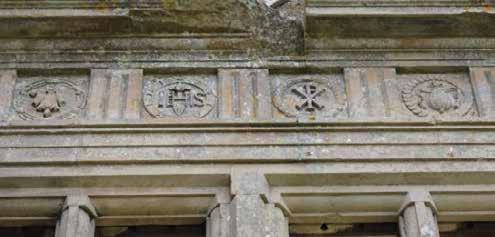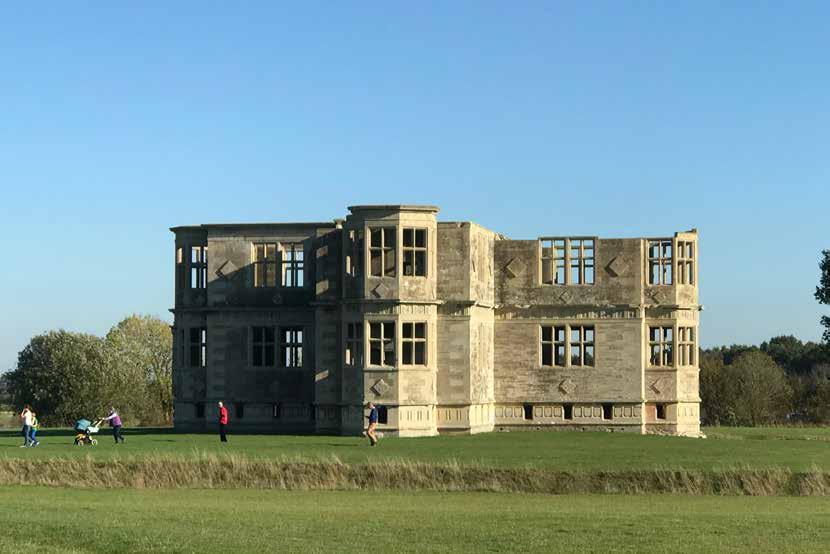
6 minute read
Tresham’s Garden Lodge
Tom Quinn visits a remarkable monument to the Catholic Faith
The Triangular Lodge at Rushton in Northamptonshire is well known. This extraordinary structure was built in the 1590s by Sir Thomas Tresham as a physical symbol of his Catholic Faith, a faith at that time under attack. Despite being knighted by Elizabeth I in 1575, Tresham, like many Catholics at the time, was continually fined for his recusancy and imprisoned for many years. But the Triangular Lodge is a statement to the world that not for anything would he give up his Faith.
Wherever you look the number three is locked into the design of the Triangular Lodge – as well as being three sided (hence triangular) the building has trefoil windows and three floors; each wall is 33ft long and surmounted by three gargoyles; and there is a delightful pun that links the number three to family intimacy: the inscription above the door reads, ‘Tres testimonium dant’ meaning ‘the number three bears witness’, a quotation from the Gospel of St John, but also a reference that only the family would have understood – Sir Thomas Tresham was always referred to as, ‘My Good Tres’ in letters written by his wife.
The lodge is covered in many other carvings – a pelican (symbol of Christ and the Eucharist), a chalice, the monogram IHS, the dates of the Creation and the calling of Abraham, and much more.
But if Tresham’s Triangular Lodge is well known, the same is not quite so true of another building he commissioned as a tangible reminder of his faith: this is Lyveden New Bield. The Triangular Lodge was really a sort of magnificent folly, never intended as a place where someone might live; Lyveden, by contrast, was designed as a summer house, a private Catholic retreat away from the prying eyes of the accusatory and the unsympathetic.

Air time: Lyveden is built in the shape of a Greek cross
Built a little later than the Triangular Lodge and some eleven miles from Rushton, Lyveden was unfinished at Tresham’s death in 1605, and it has remained largely untouched since that date, a ghostly reminder of religious faith at one of the darkest times for Catholics in England.
Lyveden seems almost as remote today as it was in the early seventeenth century. A tiny road runs for what seems like miles across wide fields from the main A6116 north of Thrapston, until we reach Lyveden Old Bield, the manor house where the Treshams lived and entertained when they were away from the family seat at Rushton Hall. A good walk beyond Old Bield we reach New Bield, although, confusingly, New Bield is actually older than Old Bield!

Decorated friezes
Powerful figures
Sir Thomas Tresham was born in 1543 into a wealthy landowning family and brought up in the Catholic Throckmorton household, where he was the ward of Sir Robert Throckmorton. In 1566 Sir Thomas married Muriel Throckmorton. As a young man he was widely seen as devout, gifted and sure of a great future. He became an avid book collector and corresponded regularly with some of the most powerful figures in the land: with William Cecil, Elizabeth I’s secretary of state, for example, and with Lord Chancellor Christopher Hatton.

Lyveden New Bield today: a monument to one man’s Catholic faith
Until the 1580s Elizabeth stuck largely to her policy of not ‘opening a window into men’s souls’. But as the perceived threat from Spain increased, along with the crisis over Mary Queen of Scots, Catholics were increasingly ostracised and persecuted. The idea that as a Catholic he was automatically to be considered disloyal was utterly rejected by Sir Thomas, but his declaration that a man must believe according to his conscience brought him under increasing suspicion. The situation was made more difficult because his association with the Jesuit St Edmund Campion was well known. Any chance that Sir Thomas’s life as a public figure might have flourished were dashed: between 1581, when he gave shelter to Campion, and his death in September 1605 he paid fines totalling nearly £2 million in today’s money. He also spent a total of 15 years either under house arrest or in prison.
But if Sir Thomas failed to establish a legacy as a man of affairs he succeeded magnificently as a builder of Catholic monuments.
Built in the shape of a Greek cross, Lyveden New Bield is rich with Catholic symbolism: it has three rooms on each floor and friezes along the outsides of all the external walls, each frieze richly carved with Catholic and Biblical symbols, including the IHS Christogram. Lyveden has one additional and especially remarkable feature – in what would have been the parlour, a window has been designed so the morning sun casts a shadow into the room in the shape of a cross. In another room a small projecting stone shelf high up in one corner shows where a statue of Mary would have been placed.
Lyveden New Bield has been described as a secret house – examples of such houses exist at other great estates – but Sir Thomas himself referred to it as a ‘garden lodge’ and certainly the original gardens which led up to the lodge were a central part of the overall plan for the site. There were to have been walnut walks, a maze, avenues of other trees, and all leading up to the lodge itself. The idea was to provide a delightful walk from the manor house to the lodge. Today, little remains of that early garden, except the moat and several mounds with spiralling paths. A magnificent orchard existed here too, and the National Trust has now restored much of it –the first step in an ambitious plan to restore the gardens as Sir Thomas originally planned them.
Gardening writer Sarah Salway explains how Sir Thomas wrote to his wife from prison with instructions for the builders and gardeners. She writes:
‘Obviously there are no original plants remaining [at Lyveden] but significant plants that Tresham notes in his letters… would have been Campion (Mary’s Rose or Lady’s Candles), Anemone (Candlemas Caps), Raspberry (symbol of Christ’s Passion), Wormwood (Mary’s Tree) and Hawthorn (Mary’s Mayflower). You can still see traces of the labyrinth which represented a spiritual journey on the one true path…’
After Sir Thomas’s death his son, Francis, was implicated in the Gunpowder Plot. Francis was arrested and held in the Tower of London, but died, apparently from natural causes, before he could be executed, as he certainly would have been had he lived. Francis’s mother continued to administer the family estate on behalf of Francis’s younger brother Lewis, but Lewis was a dissolute young man and seems to have spent much of the family fortune after his mother’s death in 1615.
Lyveden Old Bield - the nearby manor house - was largely rebuilt by Lewis (which is why it is not as old as New Bield!), but it was confiscated, because of the family’s continued recusancy, by Cromwell in 1649. The Treshams’ connection with their manor house and its extraordinary summer lodge was finally severed.
Had Sir Thomas not died in 1605 he would certainly have tried to finish his ‘garden lodge’, but it might then have attracted more attention in the coming years and been altered or extended or even demolished. Left almost a shell, it must have seemed relatively harmless – especially after a local landowner stole the roof timbers and floors - and in its remote corner of Northamptonshire it was no doubt quickly forgotten. But how marvellous for us, today, that we can revisit this monument to one man’s religious courage.










